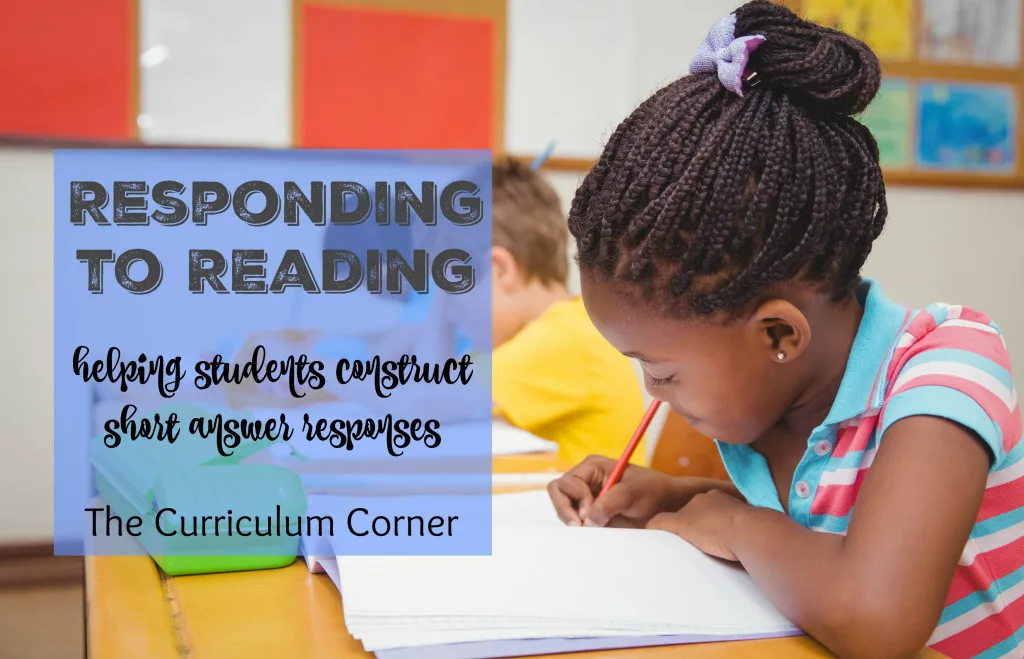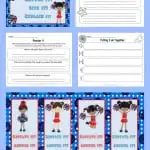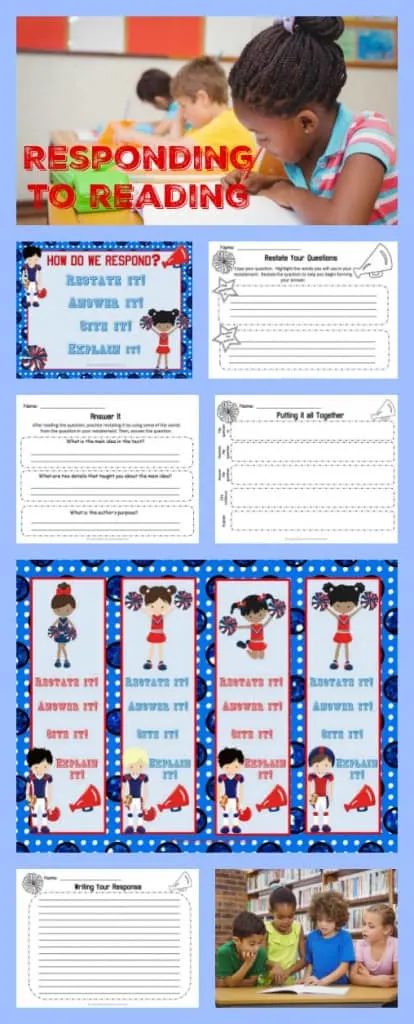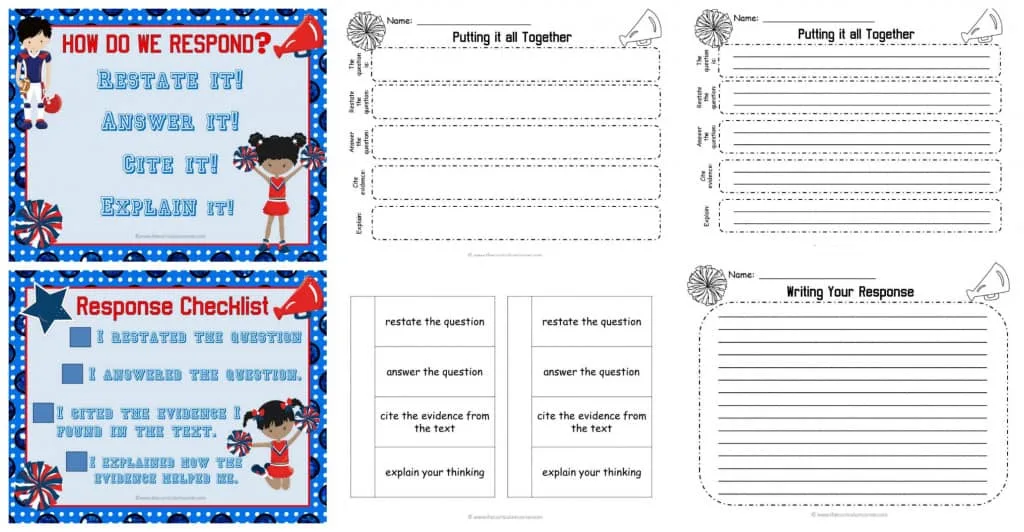This collection of literature response materials can be used to help students with forming written literature response.
 Responding to literature in more formal ways, such as for assessments or in standardized testing situations, can be daunting for students.
Responding to literature in more formal ways, such as for assessments or in standardized testing situations, can be daunting for students.
We want to make sure they have the tools they need to answer questions about their reading in concise, yet focused and effective ways, so that forming written responses to questions about literature doesn’t overwhelm them.
*** You can download the complete, free collection as described below at the bottom of this post. Look for the bold, red titles. ***
We have created this collection of resources to work on response to literature with a “cheer/sports” theme because we want to give students some type of emotional “hook” to remember the important parts of a written response.
Ideas for setting the stage for a memorable introduction:
- bring in pom poms, a megaphone, pennants or other sports fan types of items
- play some school song type music to get your students excited too
- encourage your students to wear sports related shirts or jerseys during the days you will be teaching this strategy.
The idea is that students will think of each piece of the written response strategy as a cheer that they will yell out or chant as you ask them the question
The teacher says: “How do we respond?”
Students answer: “Restate it! Answer It! Cite It! Explain It!”
**Fun Classroom Visual: To give your students a visual reminder of the response strategy, choose four students dressed in sports jerseys. Have them hold up each of the response strategy signs and take individual pictures. Blow them up and put them on your bulletin board.
We suggest that you spend two to three days on each piece of the written response strategy below.
We have provided resources for literature response that can be used during your mini-lessons, but also as practice pages for students if needed.
You will want to use familiar books and passages to teach and reinforce your mini-lessons.
Resources You Will Find
- anchor charts
- bookmarks
- exit tickets
- interactive notebook pages
- other types of specific related resources to help you teach each of the following parts of written responses: restate, answer, cite and explain
An Overview of Some Lessons
Restate & Answer the Question
- Give your students specific instruction for how to use the words within questions in their responses. In this way, it also helps them to be sure to answer the question being asked. For example, if the question asks “Who is the main character in the story?” Students would respond simply with “The main character in the story is…” Of course that type of question might not necessarily need evidence from the text, but simple questions are a great way to begin teaching students how to restate questions. Another example might be “How does the character change throughout the story?”
- We want students to begin their responses with something like “Grace changes throughout the story in a few ways,” and then move on to writing more sentences with evidence from the text to support how Grace changed in a few ways.
- The resources we have created for Restating & Answering the Question can be used as a scaffold for students to make sure they are answering questions specifically.
Cite Evidence from the Text
- Citing evidence to support an answer can be the most difficult part of responding to reading.
- We suggest modeling this skill many times with your students, using both the guided resources we have created and in several shared writing responses.
- Another great form of practice with citing evidence can occur when you are reading and discussing books orally.
- Posing questions to students about a story and then requiring them to share what parts made them answer in the way that they did, gives them lots of opportunity to get better at this skill.
- During these times, you will want to be sure to point out specifically how the evidence supported the answer so that students get lots of exposure to this skill.
- Also, when responding to the text, students should always cite at least one piece of evidence, but you can also encourage them to find more parts of the story to support their answers.
Explain Your Thinking
- As students are learning to find parts of text to support their answers, we also want to press them further with their thinking by asking them to explain how the evidence they provided supports the answer they chose.
- Again, they will need multiple opportunities, both oral and in writing, to practice thinking through a solid explanation of their thinking.
- Constant modeling of this response strategy by encouraging students to always explain their thinking after giving an answer and providing evidence from the text is, again, key to their success.
- Use our resources again and again with different literature and informational texts to help scaffold their learning and commit all the parts of a reading response to their long term memory.
Some teachers choose to have their students work on literature response in notebooks, while others may be more comfortable with scaffolded graphic organizers or more guided pages.
For some other ideas, or for more advanced students, you might want to check out the post on Reading Response Letters we created for intermediate students.
However and wherever you choose to have your students respond to their reading, just be sure that they are getting practice responding to different genres and have a solid understanding of what needs to be included in those responses.
****** You can download the resources for this unit here: Responding to Reading (Click the words to download all of the resources we created. A Black & White Version is also available.) ******
In addition to books for students to practice response to literature, you might also want to provide some passages for your students to respond to. Try ReadWorks.org! It has some really great passages you can use for a focus on literature response.




Launching Readers' Workshop - The Curriculum Corner 123
Friday 21st of June 2019
[…] Lesson 18: Asking Questions Before, During and After Reading – Students need to learn to purposefully and spontaneously ask questions as they read. Use this graphic organizer (Question & Answer Map) to model asking questions while you read. You can print it and let students fill in as they go along, put it on the smartboard or print one on the poster maker. After completing the model as a class, have students practice on their own during independent reading. Go here to find more resources to extend this lesson: Responding to Reading […]
Reading Response Activities - The Curriculum Corner 123
Saturday 13th of October 2018
[…] You might also like: Reading Response Unit of Study. […]